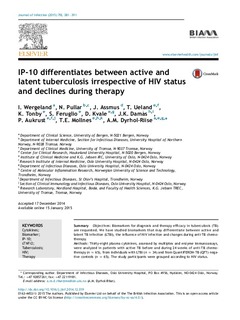IP-10 differentiates between active and latent tuberculosis irrespective of HIV status and declines during therapy
Wergeland, Ida; Pullar, Nadine Durema; Assmus, Jörg; Ueland, Thor; Tonby, Kristian; Feruglio, Siri; Kvale, Dag; Damås, Jan Kristian; Aukrust, Pål; Mollnes, Tom Eirik; Dyrhol-Riise, Anne Ma
Journal article, Peer reviewed
Permanent lenke
http://hdl.handle.net/11250/2367653Utgivelsesdato
2015Metadata
Vis full innførselSamlinger
Sammendrag
Objectives:
Biomarkers for diagnosis and therapy efficacy in tuberculosis (TB) are requested. We have studied biomarkers that may differentiate between active and latent TB infection (LTBI), the influence of HIV infection and changes during anti-TB chemotherapy.
Methods:
Thirty-eight plasma cytokines, assessed by multiplex and enzyme immunoassays, were analyzed in patients with active TB before and during 24 weeks of anti-TB chemotherapy (n = 65), from individuals with LTBI (n = 34) and from QuantiFERON-TB (QFT) negative controls (n = 65). The study participants were grouped according to HIV status.
Results:
Plasma levels of the CXC chemokine IP-10 and soluble TNF receptor type 2 (sTNFr2) significantly differentiated active TB from the LTBI group, irrespective of HIV status. In the HIV-infected group the sensitivity and specificity was 100% for IP-10 with a cut-off of 2547 pg/mL. Plasma IP-10 declined gradually during anti-TB chemotherapy (12–24 weeks, p = 0.002) to a level comparable to LTBI and QFT negative control groups. sTNFr2 fluctuated throughout therapy, but was decreased after 12–24 weeks (p = 0.006).
Conclusions:
IP-10 distinguished with high accuracy active TB from LTBI irrespective of HIV infection and declined during anti-TB chemotherapy. Plasma IP-10 may serve as a diagnostic biomarker to differentiate between the stages of TB infection and for monitoring therapy efficacy.
